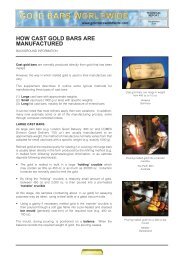Indian Gold Book:Indian Gold Book - Gold Bars Worldwide
Indian Gold Book:Indian Gold Book - Gold Bars Worldwide
Indian Gold Book:Indian Gold Book - Gold Bars Worldwide
Create successful ePaper yourself
Turn your PDF publications into a flip-book with our unique Google optimized e-Paper software.
ROLE OF INDIAN GOVERNMENT<br />
GOLD CONTROL RULES 1963 AND THE GOLD (CONTROL) ACT 1968<br />
HISTORICAL PERSPECTIVE<br />
To explain the growth in the <strong>Indian</strong> gold market since the repeal of the <strong>Gold</strong> (Control) Act in June 1990, it is<br />
important to understand how the market had been constrained over the previous 27 years.<br />
The story begins on 10 January 1963 when a comprehensive range of <strong>Gold</strong> Control Rules were promulgated as part of the<br />
Defence of India Rules 1963. The Government’s objective was to inhibit unofficial gold imports and the consumption of gold<br />
by imposing severe bureaucratic constraints not only on the trade but also on private owners. By December 1963, control<br />
over the domestic trade and distribution of gold was firmly established.<br />
In 1965, Parliament endorsed the Government’s policy underlying the <strong>Gold</strong> Control Rules through the <strong>Gold</strong> (Control) Act<br />
1965, but before the Act could be brought into force, the Government recognised the need to modify some aspects.<br />
Modifications - including the withdrawal of a 14 carat purity restriction on gold jewellery applied since 1963 - were then<br />
included in the Defence of India (Fourth Amendment) Rules 1966. Rather than amend the <strong>Gold</strong> (Control) Act 1965, a new<br />
<strong>Gold</strong> (Control) Act 1968 was enacted in September 1968.<br />
TRADE STRUCTURE<br />
The Act grouped gold market participants into 5 categories:<br />
• General public<br />
• Licensed refiners<br />
• Certified goldsmiths<br />
• Licensed dealers<br />
• Registered artisans<br />
All categories were controlled by <strong>Gold</strong> Control Officers based in 30 “Collectorates” around India.<br />
In summary, the role of each category was prescribed as follows:<br />
General public: Permitted to buy gold “ornaments” only, i.e. gold jewellery for the purpose of adornment. They were no<br />
longer allowed to own or buy gold bars or any non-jewellery articles. Individuals had to declare the extent of their gold<br />
ownership if it exceeded 2000 g, and families if it exceeded 4000 g. Any change in the amount owned over these limits had<br />
to be notified.<br />
Licensed refiners: Restricted to melting, refining, assaying and making of bars for the trade only. They could buy and sell<br />
primary gold but detailed records of all transactions had to be submitted to the authorities. They were not permitted to<br />
make, repair or polish any gold article or “ornament” (i.e. jewellery) or sell bars to the public. As a result, all major<br />
refiners closed down and the 49 licensed refiners (at 1989) were small operations mainly involved in melting and assaying.<br />
Certified goldsmiths: Only self-employed individuals were certified. They could buy gold bars from a licensed refiner or<br />
dealer, could receive gold for manufacturing purposes from a licensed dealer or the general public, but could not buy or sell<br />
any jewellery, article or primary gold. They could not engage more than one hired labourer, and the labourer was not<br />
permitted to make, repair or polish any jewellery. Officially, most goldsmiths became contract workers to dealers or<br />
merely refashioned old gold jewellery provided by the public. The constraints also ensured that almost all <strong>Indian</strong> jewellery<br />
remained handmade. At 1989, 379,883 individuals were certified.<br />
Licensed dealers: The term “dealer” covered all entities involved in buying or selling gold or gold jewellery among trade<br />
counterparties or gold jewellery with the public, although most were jewellery retailers. However, other entities were<br />
included in this category: wholesalers and manufacturers (dealing in gold in some way or employing artisans) had to be<br />
licensed as dealers. There were many constraints: they could deal only on the premises specified in the licence, they could<br />
not sell bars to the public, they could have in their possession only gold bars made by licensed refiners - the quantity<br />
restricted to a maximum of 400 g if they employed one artisan, rising to a maximum of 2000 g if more than 20 artisans were<br />
employed. All movements of gold, down to the last gramme, had to be officially recorded. Even carrying samples was<br />
extremely difficult. For all dealers, the bureaucracy and restrictions were oppressive. In 1989, there were 16,662 licensed<br />
dealers.<br />
Registered artisans: Defined as a person who was employed or used by a licensed dealer (i.e. not a certified goldsmith)<br />
in order to manufacture gold jewellery, having been supplied with the necessary gold to undertake the task. No figures on<br />
the number of registered (and unregistered) artisans are available. According to the trade, few artisans were registered.<br />
AN INTRODUCTION TO THE INDIAN GOLD MARKET 33

















